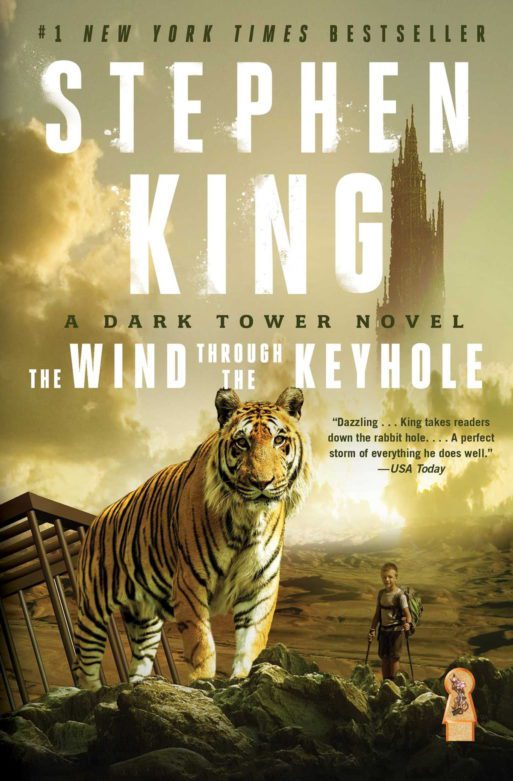 On June 19th, 1999, famed horror author Stephen King was walking on the side of a quiet country highway outside of Lowell, Maine, when, he was struck by a pickup truck, the driver distracted by his dog in the back seat. King suffered a collapsed right lung, scalp lacerations, and a fractured hip. For a time, his survival was in question. Legions of fans around the world waited with baited breath, because, selfish creatures that fans are, they all knew that King had far more work left in him, most notably, perhaps, being the concluding chapters of his epic fantasy/horror Dark Tower series. In the worlds that King had created through this series, the fabric of reality was crumbling. The eponymous Dark Tower was something of a universal lynchpin, holding the different worlds together, and it was under assault. Roland’s own world, Mid-World, which may or may not have been Earth in the distant future, was disintegrating. Civilization had collapsed. Demons and dark mages and mutants were running wild and the laws of nature were no longer laws. Roland was on a mission to find the Dark Tower, and to find out what was going wrong. He was on a mission to save the universe, though from what exactly we do not know.
On June 19th, 1999, famed horror author Stephen King was walking on the side of a quiet country highway outside of Lowell, Maine, when, he was struck by a pickup truck, the driver distracted by his dog in the back seat. King suffered a collapsed right lung, scalp lacerations, and a fractured hip. For a time, his survival was in question. Legions of fans around the world waited with baited breath, because, selfish creatures that fans are, they all knew that King had far more work left in him, most notably, perhaps, being the concluding chapters of his epic fantasy/horror Dark Tower series. In the worlds that King had created through this series, the fabric of reality was crumbling. The eponymous Dark Tower was something of a universal lynchpin, holding the different worlds together, and it was under assault. Roland’s own world, Mid-World, which may or may not have been Earth in the distant future, was disintegrating. Civilization had collapsed. Demons and dark mages and mutants were running wild and the laws of nature were no longer laws. Roland was on a mission to find the Dark Tower, and to find out what was going wrong. He was on a mission to save the universe, though from what exactly we do not know.
King survived the accident, and he soon got back to work. The fifth Dark Tower installment was to come four years later, though to this author’s reading, the final books written after the car accident, Wolves of the Calla, Song of Susannah, and The Dark Tower, were far inferior to the prior four. They came across as somehow comic bookish, their new storylines tangential. The spectacularly fiendish villains King had developed in the earlier books proved disappointingly easy to vanquish. The Dark Tower VII: The Dark Tower was, in the end, a disappointment. The Wind Through the Keyhole, released this year, yet chronologically situated between the fourth and fifth books (King has called it The Dark Tower 4.5) was a chance for King to set things right.
Interestingly enough, one of the greatest problems with the last three books was the author’s attempt to address his own brush with death. A seven-book epic, whose writing spanned three decades, 5,000+ pages and almost as many characters, could not have been the easiest of undertakings, and at times the series’ completion must have seemed less than assured. Following his car accident, and the presentation of the very real possibility that the series would never be finished, King could not help but follow this idea a little bit further, and he ended up writing himself into the books. That is, he created a character who is a famous horror author named Stephen King. This Stephen King was one particular reality’s incarnation of the Dark Tower, therefore his death would have meant that the worlds he was creating would have been destroyed. Roland’s mission now was to save Stephen King from getting hit by a car. The Dark Tower books, in essence, became about the books themselves being written, and Roland’s quest, therefore, about little more than Roland completing his quest. While this idea might be intellectually interesting, it tends to superficialize the books and diminish their justification, which, lengthy as the series is, should be considerable.
“The two most beautiful words in any language are: I forgive.”
Thankfully, Wind Through the Keyhole forgets all of these problems. Bringing his band of Gunslingers back to the middle of their journey, just following a confrontation with Randall Flagg, one of King’s most enduring villains, they are beset upon by a demonic storm called a starkblast. While they batten down the hatches, Roland tells them stories through the night, experiences from his childhood, and a fairytale, magical and terrifying, that showcases King at his very best, and deepens further the intrigue of Mid-World, whose creation, we readers are reminded, was quite an achievement. Indeed, there just might be plenty more stories to be found within it.
The epigraph to this book ends thusly: “The two most beautiful words in any language are: I forgive.” On behalf of moderately disappointed Dark Tower readers everywhere, let me say, “Mr. King, I do indeed.”
- Check out our review of the recent indie film Beasts of the Southern Wild
- Death is a constant in all literature — discover how Tennessee Williams grappled with subject through poetry

 “The Wind Through the Keyhole,” by Stephen King
“The Wind Through the Keyhole,” by Stephen King



 “As Tears Go By” by Marianne Faithfull
“As Tears Go By” by Marianne Faithfull

 Funeral Favors Offer Visitors a Tangible Memento
Funeral Favors Offer Visitors a Tangible Memento















